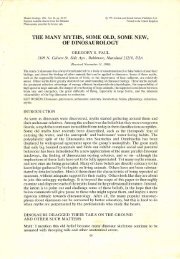HUNTERIA - Gregory S. Paul
HUNTERIA - Gregory S. Paul
HUNTERIA - Gregory S. Paul
Create successful ePaper yourself
Turn your PDF publications into a flip-book with our unique Google optimized e-Paper software.
of the hand. Contrary to previous reports, the sauropod hand<br />
is not at all elephant-like - in fact it is unique and has only<br />
a thumb claw and no hooves. As restored the femur/tibia<br />
or fibula ratio of SITis a little higher than in other specimens<br />
(Table 1), but as the femur is always just a little shorter than<br />
the humerus in brachiosaurs, this ratio must be correct. The<br />
hindlimb is also columnar, and the foot is unguligrade and<br />
very elephant-like (excepting the three or four big laterally<br />
splayed banana claws; the outer one or two toes are neither<br />
clawed nor hooved). The astragular distal articulation faces<br />
more downwards and less forwards in well preserved sauropod<br />
ankles, relative to those of digitigrade prosauropods; therefore<br />
the sauropod foot is posturally unguligrade instead of plantigrade<br />
as suggested by Cooper (1984). The extremely short<br />
metatarsus and toes backed by a big pad show that the ankle<br />
was nearly immobile. The animal is shown in an elephantlike<br />
amble (Muybridge, 1887), its fastest gait.<br />
The most important point about the mounted HMN Sll<br />
is that the presacrals on display are not the originals, they<br />
are plaster models. The centra of the dorsal models are<br />
significantly larger than those of the originals, and Janensch's<br />
(1950b)paper skeletal restoration includes the s.ameerror. Why<br />
the modeled centra are so long is not clear, for although the<br />
dorsals are moderately crushed and too fragile to mount, most<br />
of the centra appear to be little altered in length. With centra<br />
of proper length, the dorsal column of B. brancai is some<br />
20% shorter relative to the limbs than indicated by ]anensch,<br />
even though one more vertebra is included in the new restoration.<br />
Other errors in Janensch's restoration include vertical<br />
anterior dorsal ribs and a shoulder girdle that is consequently<br />
too far forward - as well as too high - on the ribcage; scapula<br />
and humerus too short, a sprawling forelimb, and a tail that<br />
is too long, too heavy, and droops. Burian's well known<br />
restoration of the species emphasizes these errors, and also<br />
shows the neck much too short (Spinar and Burian, 1972)~<br />
In addition the claws are incorrect. Because the new restoration<br />
has a scaled up HMN Aa tail that is longer than it is<br />
in the mount and a dorsal column that is shorter, the<br />
differences cancel each other and the new restoration and the<br />
mount share nearly the same length of over 22 m.<br />
A very unusual feature ofB. brancai is the extreme height<br />
of dorsal vertebra 4, especially the neural spine, relative to<br />
both the cervicals and posterior dorsals. Unfortunately the<br />
immediately surrounding neural spines are not preserved, but<br />
it appears that this sauropod had "withers", tall neural spines<br />
over the shoulders (Figs. 1, 2B). Rebbachisaurus garasbae,<br />
a species possibly assignable to the Brachiosauridae, may have<br />
even taller withers (Lavocat, 1952).Withers are fairly common<br />
among mammals, but are unknown among other dinosaurs<br />
except for the chasmosaurian ceratopsids. This feature suggests<br />
that nuchal ligaments helped to support the neck. The withers'<br />
modest height and the long neck suggest the ligaments were<br />
rather low, like a camel's (Knight, 1947; Dimery et al., 1985).<br />
The ossified cervical "ligaments" cited by Migeod (1931) and<br />
Alexander (1985)are more probably displaced ends of the long<br />
cervical ribs (McIntosh, pers. comm.). Also unusual is the small<br />
size of the posterior dorsals, especially the centra. HMN Sll<br />
<strong>HUNTERIA</strong> VOL. IT, no. 3, pp. 4, February 19, 1988<br />
GREGORY S. PAUL<br />
and BMNH M 26 have posterior centra that are only 9 inches<br />
long! Although brachiosaur posterior dorsals are very different<br />
from the great posterior dorsals and sacrals of diplodocids, it<br />
does not follow that brachiosaurs were weak in the back.<br />
Obviously these giants did perfectly well with the posterior<br />
dorsals they had. Brachiosaur dorsals were not as specialized<br />
for rearing up as were diplodocid dorsals (Bakker, 1971C,1978).<br />
On the other hand brachiosaurs were like all other dinosaurs<br />
in being hindlimb dominant - the center of gravity was<br />
towards the rear so the hindlimb was more robust and supported<br />
more weight than the forelimb. This weight distribution<br />
made it easier for brachiosaurs to rear in search of choice<br />
-I









